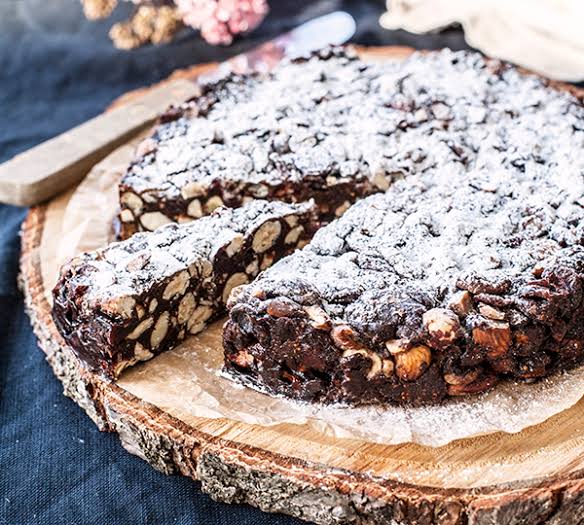Of course, you know that I mean panforte, that dense, sweet, spiced, fruit, nut and honey cake best eaten with coffee in a café off of a square in Florence (or even Siena). There is a little cafe behind the Biblioteca Nazionale Centrale di Firenze, the main library in Florence, off of the Via Tripoli, and they are open long into the evening, with a few promenading customers. Every five years, on our anniversary, we would visit in the evening and have coffee and panforte. I still remember the smell and taste of the ‘strong bread’. Strong, because of the spices used to flavour this durable confection.
Originating in Turkey and brought back by the Latin Christians between 1095, the time of the first crusade, and well before 1291, when the final expulsion took place from their kingdom in Syria, there are references to panforte being a food to help survive sieges, marches and long voyages.
Italian documents from 1205 show that panforte was paid to the monks and nuns of the local Abbey of Montecelso in Siena, as a tax or tithe which was due on the seventh of February that year. At this time the Sienese called this type of panforte ‘panpepato’ or peppered bread and this version with lots of pepper and other spices is still available.

The Comune Di Siena say, however, that rather than panforte deriving from panpepato, panpepato derives from panforte and was created by Sister Berta when Siena was under siege (1494-98). She had become so concerned for the health of the residents that she set about making a cake based on the original panforte recipe. Instead of fresh fruit, she packed the cake with dried fruit, honey and nuts and spiked it with spicy pepper. The Gourmet Traveller provides a recipe for panpepato which looks delicious. Note the use of pink peppercorns and black pepper.
Panforte recipes are passed on through families and communities across generations. There are many varieties of Panforte with the most famous carrying the names of ancient pharmacists who once took on the role of baking the panforte. Visit Tuscany tells us that:
“The recipe for panpepato remained unaltered over the centuries until 1879, the year when Queen Margherita of Savoy visited Siena. In honour of her visit, a local spice seller made a version of the cake without melon and with a layer of vanilla-flavoured sugar on top instead of black pepper. The people of Siena gave this ‘white’ version of panforte to Queen Margherita* and called it ‘Panforte Margherita’ in her honour. This more delicate version is the one still sold today. The consistency is soft, the flavor is sweet, with an aftertaste of candied fruit, almonds and a hint of spice. In 2014 Panforte from Siena obtained the PGI (Protected Geographical Indication) European designation of quality label.”
Visit Tuscany.
*Note: this is the same Margherita, The Queen of Savoy, who had inspired Raffaele Esposito to prepare a special pizza for her.
Felicity Cloake in 2017 wrote excellently for the Guardian ‘How to make the perfect Panforte’, but the recipe I will give you here is from Rachael Roddy, writing in the same newspaper just last month. It is a lighter version which I think is more suited to the hotter Christmas weather in New Zealand. But it still has all the taste and ingredients – just a little less.
So, having said all of that I do think it is time for a recipe. Enjoy.
Panforte
Prep 20 min, Cook 10 min, Makes 16 slices
Ingredients
- 200g honey
- 250g caster sugar
- 300g mix candied orange, citron, pitted dates, prunes or sultanas
- 250g roasted almonds or hazelnuts, or a mix of the two
- 100g plain flour
- ½ tsp ground cinnamon
- ½ tsp ground cloves
- ½ tsp ground nutmeg
- Icing sugar, to dust
Method
1. Line the base and sides of a 20cm cake tin with baking paper. Heat the oven to 220C (200C fan)/gas 7. In small pan over a low heat, warm the honey and sugar until the sugar has completely dissolved. Pour into a bowl.
2. Roughly chop the dried fruit and nuts, and add to the bowl, followed by the flour and spices, stirring as well as you can.
3. Scape the mixture into the lined tin, then use a knife dipped in hot water to smooth the top. Dust with icing sugar, then bake for 10 minutes.
4. Leave to cool before removing from the tin, then dust with more icing sugar, and serve.

